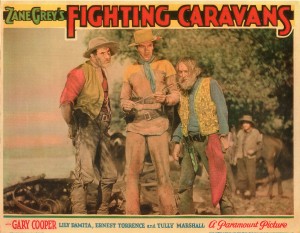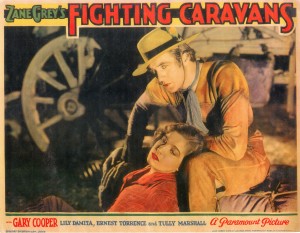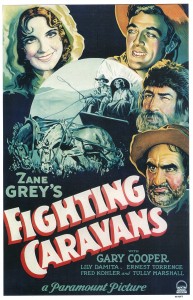by Barb Lentz.
The five movies Bob provided me from which to choose were these:
Chinatown (1974)
Fighting Caravans (1931)
Goodbye, My Lady (1956)
Hamlet (1948)
RoboCop (1987)
I chose Fighting Caravans for a couple of reasons. It is the oldest title, and it is a Gary Cooper western. We had seen The Westerner last year, and I liked that one a lot. Mainly, however, I picked it because of our association with the Zane Grey’s West Society, which promotes and celebrates the writings of Zane Grey. Making this choice permits me to see a new Zane Grey western and to discuss the Society a bit in context with the movie.

Set during the Civil War period, this western follows the typical Zane Grey path of eastern people moving west to find their destinies. A wagon train is heading to California, led by three scouts (Gary Cooper, Ernest Torrence, Tully Marshall). A woman (Lili Damita) who wants to make the trip to honor her father’s wishes is coerced into pretending to be the bride of scout Clint Belmet (Cooper). Their stormy relationship ebbs and flows in the wilderness as the hardy travelers encounter swollen rivers, deep snows, angry Indians and mud. Through it all the three scouts keep the wagons moving, no matter what.
It isn’t just about this specific wagon train, though. Some westerns seem timeless, but Fighting Caravans is rooted deeply within its era. The Civil War is mentioned near the beginning but the travelers pay the eastward fighting no mind; they are headed west to start new lives. Yet before they reach the protection of an Army fort they meet the soldiers, who have been ordered back east to join the fighting! This leaves them without an escort or protection from the marauding Indians.
The second thing is that the older scouts, Bill Jackson (Torrence) and Jim Bridger (Marshall) seem to be part of the past, unable or unwilling to accept that progress, like the travelers themselves, is heading west. Eventually, alone with Clint Belmet, they acknowledge that the coming railroad is going to change everything, and that they had better learn to adapt, or find a new calling. This manner of self-awareness is typical of Grey’s books, which were usually based on actual people, incidents and trends of the time.
My top five aspects of the movie are:

1. The realism of the trek across unconquered America. We can drive from Maine to California in less than a week; these wagon trains moved about twelve miles a day across the open territory! The film does a nice job of detailing the troubles these travelers would encounter, showing how much danger the wagons would find in deep mud, steep hills and all those rocks. I can’t even imagine how they were able to cross the Rocky Mountains safely. Not to mention the rivers and storms! The pioneer spirit was truly amazing.
2. I like that Felice is so spirited. It’s a little odd that this French-accented woman is on the trail at all, but she is as brave and hardy as anyone. One of Grey’s hallmarks is the strong female characters who populate his fiction. Western movies as a rule don’t concern themselves too much about the womenfolk, but Grey was different. Many of his stories actually focus on the female experience in the West, which may be why his books do not transfer so well to the big screen. Felice is a typical Grey heroine, standing up to the older scouts when she discovers their deception about Belmet, still unwilling to go back even when it means putting up with them for the rest of the trip.
3. The friendship of the scouts. Bill Jackson and Jim Bridger are like an old married couple, thoroughly accustomed to being together and knowing what the other is thinking. It is perfectly appropriate that they finish the fight against the Indians as they do, killing the traitor and then dying together. It is also touching how they have trained and coached Clint for so long to be like them, only to have him swoon for Felice and an altogether different kind of life.
4. The film’s opening is attention grabbing. It has the two scouts looking for Clint Belmet in town, finding him sleeping in the jail, and watching him walk out scot free. Then, the sheriff wants to arrest him for something, I never understood what. It is at this point that the scouts coax Felice into saying she is Belmet’s newlywed wife!
5. The on-location filming. Most of the movie was actually filmed outside, in the California highlands. The scenes of wagons pushing through deep snow and moving across the river are real. According to Bob this was an expensive production, and the money is on the screen, as they say.
 Despite these positive aspects I must admit that I was not thrilled with the movie. There is too little action and too much talk, especially from Bill Jackson and Jim Bridger. I found Gary Cooper rather bland in one of his first major starring roles; I liked him much better in The Westerner. The movie’s location shooting is impressive, yet the pacing really doesn’t seem to move. Bob tells me the DVD print — the only version currently available — is missing about ten minutes, which may account for some jumpiness. All I can say is that I expected more from this production. What is on screen is okay, but not exceptional.
Despite these positive aspects I must admit that I was not thrilled with the movie. There is too little action and too much talk, especially from Bill Jackson and Jim Bridger. I found Gary Cooper rather bland in one of his first major starring roles; I liked him much better in The Westerner. The movie’s location shooting is impressive, yet the pacing really doesn’t seem to move. Bob tells me the DVD print — the only version currently available — is missing about ten minutes, which may account for some jumpiness. All I can say is that I expected more from this production. What is on screen is okay, but not exceptional.
Is Fighting Caravans a classic? I think not. While this movie seems to be in keeping with Zane Grey’s style (I have not yet read the book), it isn’t as cinematic as it ought to have been. Despite some positive aspects the movie is rather dull rather than exciting. Gary Cooper doesn’t have the “star quality” that he showed in later films, and I grew tired of the endless banter between the older scouts. Also, the film de-emphasizes the women who also make the trip, which is a real shame. Thus, I cannot heartily recommend it. But I can recommend something else.
Zane Grey’s West Society is a non-profit organization that celebrates and promotes interest in Grey’s books. We have a convention every year, in June, where Grey lived, wrote about or had some connection. Most of the conventions are out West, which most of Grey’s western writing describes in remarkable detail. The Society also publishes a quarterly newsletter or journal, which Bob and I are going to co-edit beginning in 2016. We (the Society) published a Centennial Edition of Riders of the Purple Sage in 2012, for which Bob and I helped proofread, and for which Bob wrote an essay about the five movie versions. It is a fun group of very friendly people, and we are happy to belong. Check it out on the web at zgws.org. if you are interested.
BRL 6 August 2015.
Fighting Caravans (February 1, 1931) Paramount Pictures.
Directed by Otto Brower and David Burton.
Screenplay by Edward E. Paramore, Jr., Keene Thompson and Agnes Brand Leahy.
Adapted from the novel by Zane Grey.
Principal Cast (character, performer):
Clint Belmet Gary Cooper
Felice Lily (Lili) Damita
Bill Jackson Ernest Torrence
Jim Bridger Tully Marshall
Lee Murdock Fred Kohler
Seth Higgins Eugene Pallette
Couch Roy Stewart
Jane May Boley
Faith Eve Southern
Sheriff Charles Winninger
81 minutes. Black and White. Not Rated.
